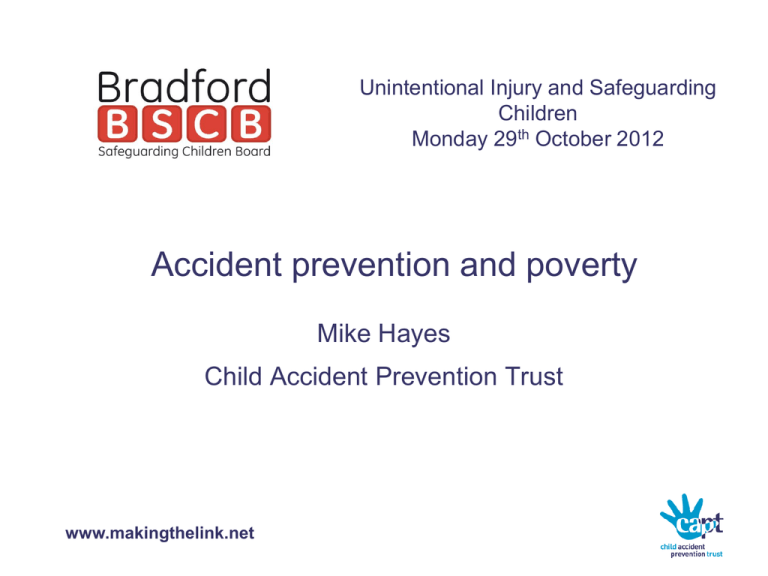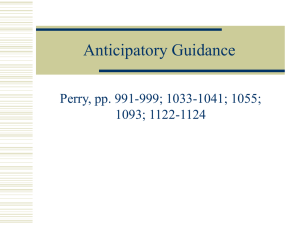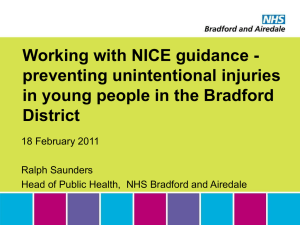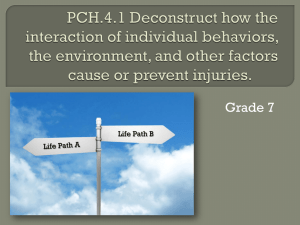Leading causes of deaths, under 5s England and Wales, 2009
advertisement

Unintentional Injury and Safeguarding Children Monday 29th October 2012 Accident prevention and poverty Mike Hayes Child Accident Prevention Trust www.makingthelink.net About CAPT CAPT is a national charity committed to reducing the number of children and young people who are killed, disabled or seriously injured as a result of accidents. CAPT provides training, publications, consultancy and information services CAPT runs Child Safety Week – community education campaign, raising awareness of serious childhood accidents & how to prevent them www.makingthelink.net CAPT’s philosophy We aim to create a safer environment in which children and young people can live, learn and play We understand that experimenting and risk-taking are part of growing up We do not want to secure low injury rates at the expense of children’s health and quality of life www.makingthelink.net www.makingthelink.net What are the consequences of injury? Pain (from injury or subsequent treatment) Fear / anxiety Physical disability Emotional effects Education – loss of schooling Disruption to usual routine (social) Family stress and breakdown Financial costs - to family, NHS and emergency services www.makingthelink.net Bradford data: source of information Child and Maternal Health Observatory (ChiMat) accident prevention report – published last Friday http://tinyurl.com/chimat-accidents www.makingthelink.net Hospital admissions for unintentional injuries: rate per 10,000 population (2010-11) 180 160 140 120 100 Under 5s 80 5-17 years 60 40 20 0 Bradford www.makingthelink.net Yorkshire and The Humber England Hospital admissions for falls: rate per 100,000 population (2008/9-2010/11) 800 700 600 500 400 Under 5s 5-16 years 300 200 100 0 Bradford www.makingthelink.net Yorkshire and The Humber England 14 Hospital admissions for burns and scalds: rate per 100,000 population (2006/7-2010/11) 12 10 8 Under 5s 6 5-16 years 4 2 0 Bradford www.makingthelink.net Yorkshire and The Humber England 14 Hospital admissions for burns and scalds - under 5s: rate per 100,000 population (2006/7-2010/11) West Yorkshire councils 12 10 8 6 4 2 0 Bradford Calderdale www.makingthelink.net Kirklees Leeds Wakefield Yorkshire and The Humber England Deaths due to unintentional injuries England and Wales, 1979 - 2010 1200 1000 No. of deaths 800 600 Under 15 400 Under 5 200 0 www.makingthelink.net Downward trend Why? Safety education, awareness-raising Increased child restraint and seat belt use and improved vehicle design Increased smoke alarm ownership Safer (and new) consumer products Improvements in medical care Changes in child behaviour, reducing exposure to hazards www.makingthelink.net Selected causes of death due to unintentional injuries by age, England and Wales, 2010 All accidents M <1 1–4 5–9 10–14 0-14 15 33 19 43 110 F 10 25 11 16 62 M 2 1 - 1 4 Falls Inanimate mechanical forces F - 1 - 1 2 M - 1 - 2 3 F - - 1 - 1 M 1 7 4 3 15 Drowning Other threats to breathing F - 4 - 3 7 M 7 13 3 11 34 F 9 www.makingthelink.net 4 - 3 16 0-14 0-4 1-14 172 83 147 6 4 4 4 1 4 22 12 21 50 33 34 On average, one child in five is taken to hospital after an accident each year www.makingthelink.net Rates of death and injury due to accidents For every death there are about 550 hospital admissions 10,500 A&E attendances. 10 admissions per 1,000 children 184 A&E attendances per 1,000 children 1 child in every 5.4 attends A&E annually About 5% of A&E attendances result in admission www.makingthelink.net Death rates per year per 100 000 children aged 0-15 years by eight class NS-SEC, 2001-3, England and Wales Higher managerial/professional occupations 1.9 Lower managerial/professional occupations 1.6 Intermediate occupations 2.9 Small employers/own account workers 2.9 Lower supervisory/technical occupations 2.7 Semi-routine occupations 4.0 Routine occupations 5.0 Never worked/long term unemployed 25.4 0 5 10 15 20 Source: Edwards P, Green J, Roberts I, Lutchmun S, BMJ, 2006;333;119-123 www.makingthelink.net 25 30 Injury mortality rates by social class Professional 17 Managerial 16 Non-manual skilled 19 Manual skilled 34 Partly skilled 38 Unskilled 83 0 10 20 30 40 50 60 70 80 European age standardised mortality rate per 100,000 population Source: I Roberts and C Power (1996), BMJ Vol 31.3 www.makingthelink.net 90 Hospital admissions and inequalities Hippisley-Cox J, Groom L, Kendrick D, Coupland C, Webber E, et al. (2002) Cross sectional survey of socioeconomic variations in severity and mechanism of childhood injuries in Trent 1992–7. British Medical Journal 324: 1132–1134. http://www.bmj.com/content/324/7346/1132 www.makingthelink.net Hospital admissions and inequalities The total number of admissions for injury and admissions for injuries of higher severity increased with increasing socioeconomic deprivation These gradients were more marked for 04 year old children than 514 year olds The steepest socioeconomic gradients were for pedestrian injuries (adjusted rate ratio 3.65) burns and scalds (adjusted rate ratio 3.49) poisoning (adjusted rate ratio 2.98) www.makingthelink.net Risk factors using GP records Orton E, Kendrick D, West J, Tata LJ (2012) Independent Risk Factors for Injury in Pre-School Children: Three Population-Based Nested CaseControl Studies Using Routine Primary Care Data. PLoS ONE 7(4): e35193. http://tinyurl.com/orton-paper > 180,000 records from GP database Thermal injuries, fractures and poisoning www.makingthelink.net Thermal injuries risk factors Male gender Increasing birth order n-shaped relationship with child age, with the highest odds of injury occurring at age 1-2 years Decreased with increasing maternal age Children living in 2-adult households had a lower odds of injury compared with those in single adult households. www.makingthelink.net Thermal injuries risk factors Increased if the mother had a diagnosis of depression in the perinatal period Adult hazardous or harmful alcohol consumption Increasing socioeconomic deprivation www.makingthelink.net Poisoning risk factors Increasing birth order Younger maternal age An even steeper n-shaped relationship with child age, with the highest odds of injury occurring at age 2–3 years Diagnosis of perinatal depression Adult hazardous or harmful alcohol consumption Increasing socioeconomic deprivation www.makingthelink.net Accident prevention and poverty The challenges Children! Our understanding of their development Our knowledge of what works www.makingthelink.net Accidents and child development the changing child Anatomical and physical characteristics Physical abilities - gross and fine motor skills Exploring behaviours Cognitive abilities Speech and language development Social and emotional development Risk behaviours www.makingthelink.net Fine motor skills Holding and manipulating objects Picking up objects Opening containers – childresistance Using “tools” – cutlery, crayon, knife, scissors Chewing, swallowing and breathing www.makingthelink.net Exploring behaviours Mouthing behaviour – risk of choking, suffocation, poisoning Colour, sound, shape, lights, texture, movement, characters and faces, shape, size, smell, resemblance to food child-appealing products natural hazards (fire, water, plants, etc) burns, drowning, poisoning, choking, electrocution www.makingthelink.net www.makingthelink.net Exploring behaviours Mouthing behaviour – risk of choking, suffocation, poisoning Colour, sound, shape, lights, texture, movement, characters and faces, shape, size, smell, resemblance to food child-appealing products natural hazards (fire, water, plants, etc) burns, drowning, poisoning, choking, electrocution www.makingthelink.net What works? What do we mean by “works”? How should we measure effectiveness? If we don’t know that a programme is effective, it doesn’t mean that it isn’t www.makingthelink.net Approaches to prevention Education and awareness-raising – who? Engineering and environmental change – modifying products, settings, etc Legislation and enforcement – nationally, locally Empowering people – giving people the ability to act. What people? www.makingthelink.net World report on child injury prevention World Health Organization and UNICEF “There is no single blueprint for success but six basic principles underlie most of the successful child injury prevention around the world. These are: Legislation and regulations, and their enforcement Product modification Environmental modification Supportive home visits The promotion of safety devices Education and the teaching of skills” www.makingthelink.net Key strategies to prevent burns among children Strategy 1 Setting (and enforcing ) laws on smoke alarms Developing a standard for child-resistant lighters Setting (and enforcing) laws on hot water tap temperature and educating the public Using thermostatic mixing valves to control hot water temperature 2 Banning the manufacture and sale of fireworks Providing first aid for scalds – “cool the burn” Conducting home visits for at-risk families 3 Distributing smoke alarms on their own (without accompanying laws) Conducting community-based campaigns and interventions Using traditional remedies on burns 1 = effective 2 = promising 3 = insufficient evidence 4 = ineffective 5 = harmful www.makingthelink.net 4 5 Key strategies to prevent falls among children Strategy 1 Implementing multifaceted community programmes such as “Children can’t fly” Redesigning nursery furniture and other products Establishing playground standards for impact absorbing surfacing, height of equipment and maintenance Legislating for window guards 2 Using safety gates and guard rails Conducting supportive home visits and education for at-risk families 3 Raising awareness through educational campaigns Implementing housing and building codes 4 1 = effective 2 = promising 3 = insufficient evidence 4 = ineffective 5 = harmful www.makingthelink.net 5 Home safety education and provision of safety equipment for injury prevention Kendrick D et al. Home safety education and provision of safety equipment for injury prevention. Cochrane Database of Systematic Reviews 2012. http://tinyurl.com/kendrick-cochrane www.makingthelink.net Home safety education and provision of safety equipment for injury prevention Overall families who received home safety education were more likely to: have a safe hot tap water temperature have a working smoke alarm and a fire escape plan have fitted stair gates have socket covers on unused sockets store medicines and cleaning products out of reach of children www.makingthelink.net Home safety education and provision of safety equipment for injury prevention Home safety education provided most commonly as one-toone, face-to-face education, in a clinical setting or at home, especially with the provision of safety equipment, is effective in increasing a range of safety practices. Home safety interventions provided in the home may reduce injury rates, but more research is needed to confirm this finding. Home safety education was equally effective in the families whose children were at greater risk of injury. www.makingthelink.net Safe at Home National Home Safety Equipment Scheme http://www.safeathome.rospa.com/evaluation.htm Evaluation report: If continued in the long term, the national programme showed potential to reduce injuries, through the combination of effective safety equipment, free installation and targeted education Has the potential to improve safety behaviours in vulnerable families and to reduce unintentional injuries www.makingthelink.net Community-based injury prevention programmes Towner et al. What works in preventing unintentional injuries in children and young adolescents? An updated systematic review. http://tinyurl.com/towner-review Key elements: Long-term strategy Effective focused leadership Multi-agency collaboration Involvement of the local community Appropriate targeting Time to develop Use of local surveillance systems to motivate participants and to evaluate interventions www.makingthelink.net Partnerships Statutory sector Local government, including public health and children’s services Health sector Emergency services, especially fire and rescue services Voluntary and community sector Support for the families in greatest need www.makingthelink.net You are not alone! www.capt.org.uk www.makingthelink.net www.makingthelink.net








